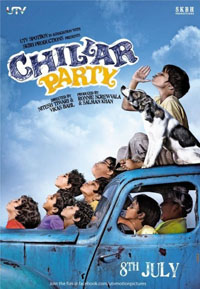
New children's films are fun for adults as well
Jul 25, 2011 Radhika BhiraniNew Delhi, July 25 (IANS) Think of children's movies and animated characters come to mind. But all that appears to be changing. With projects like "Chillar Party" and "Stanley Ka Dabba", filmmakers are attempting to change the definition of the genre through light-hearted yet mature content, packaged to appeal to a wider family audience.
But some feel that children's films should be only for their entertainment.
"It's important to create a balance with a film that cuts through every kind of audience - children and adults. A film about children can be for the children and be entertaining for a family too," Shikha Kapur, senior vice president and head (marketing), UTV Motion Pictures, told IANS.
A lot depends on the marketing of a film too.
"A film, most often, finds its target audience on its own through word-of-mouth publicity. It's the marketing which makes a difference. The marketing mix of 'Chillar Party' was like a typical Bollywood masala film. Hence, it appealed to a lot more people than just children," added Kapur.
In the last decade, filmmakers tried to lure kids with animation projects like "My Friend Ganesha", "Bal Ganesh", "Hanuman", "Hanuman Returns" and "Ghatothkach".
But more recently, filmmakers have attempted to sell issue-based movies with children as protagonists, as kids' films.
For instance, UTV Spotboy and Salman Khan's co-production "Chillar Party", a story about a gang of innocent children who stand up against a politician and save a street dog's life, tugged at many hearts. While children enjoyed it for its fun moments, adults liked it too for its message on the class differences in Indian society.
The film also had a commercial flavour thanks to Salman's association, Ranbir Kapoor's 'tapori' item number "Tai tai phish" and multiple brand tie-ups - which helped it in drawing a wider audience.
Earlier releases like "Taare Zameen Par", "Stanley Ka Dabba", "Kachha Limboo", or even Kannada movie "Hejjegalu" that won the national award for best children's film, had an underlying message tucked under the innocence and playfulness of children.
Aamir Khan's "Taare Zameen Par" deals with a dyslexic child, "Stanley Ka Dabba" takes a sensitive look at teacher-student relationship and "Kachcha Limboo" narrates the story of a 13-year-old caught in a transitional phase of adolescence. "Hejjegalu" is about a young girl, who fights poverty and an irresponsible father to become a role model to other children.
However, there is a school of thought that stresses on "just for kids" films without a serious sub-plot.
Actress Nandita Das, chairperson of Children's Film Society, India (CFSI), feels there is a need to make films just for kids.
"The producers, of course, want as many eyeballs they can get. But how can the same story and sensibility be for a six-year-old and a 60-year-old? I do think there is a need to make films specially for children to cater to their needs and aspirations," Nandita told IANS.
In her review for "Stanley Ka Dabba", film critic Shubha Shetty-Saha, also supported light films for children.
"While child labour is a pressing and immediate issue, a child need not be burdened with such an issue, while watching a film made for him or her. Even if they want to, they can't do anything about it. Why can't a children's movie be just that, without tagging a social issue along with it?" she wrote.
But how would one define an ideal children's film?
"A film that connects with the spirit of hope, curiosity, adventure and imagination that children instinctively have. A film that is neither preachy nor frothy and shallow. A film that can subtly equip children to understand the world they live in, but with lightness, optimism and joy," said Nandita.
Though India is one of the largest film-producing nations in the world, filmmakers have hardly attempted to make children-centric films.
In the past, films like "Masoom", "Boot Polish", "Safed Haathi", "Anjali" and "Makdee" have been made to cater to the kids, but they have "never been a priority", said Nandita.
To combat the problem, CFSI was launched in 1955. The aim was to produce, exhibit and distribute entertaining and enriching content for children. But it suffered from a lack of marketing budget.
However, it has new plans now, she said.
"We at CFSI are trying to see how we can market our films, both through conventional methods and by thinking out of the box. You will soon hear about some really good films that we have been working on in the last two years," said Nandita, who took over as CFSI chief in 2009.
Either it is fun film for children or the issue-based; the best part is that efforts are being made to make children films, which was a far cry a few years back.
(Radhika Bhirani can be contacted at radhika.b@ians.in)
Click the Movie button below for more info:
Chillar Party
COMMENTS
More News










